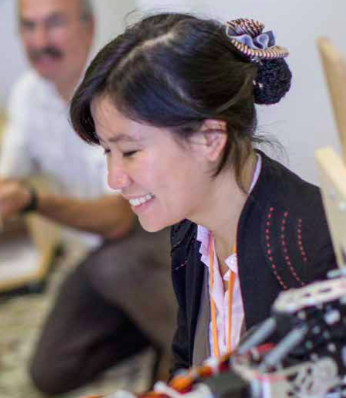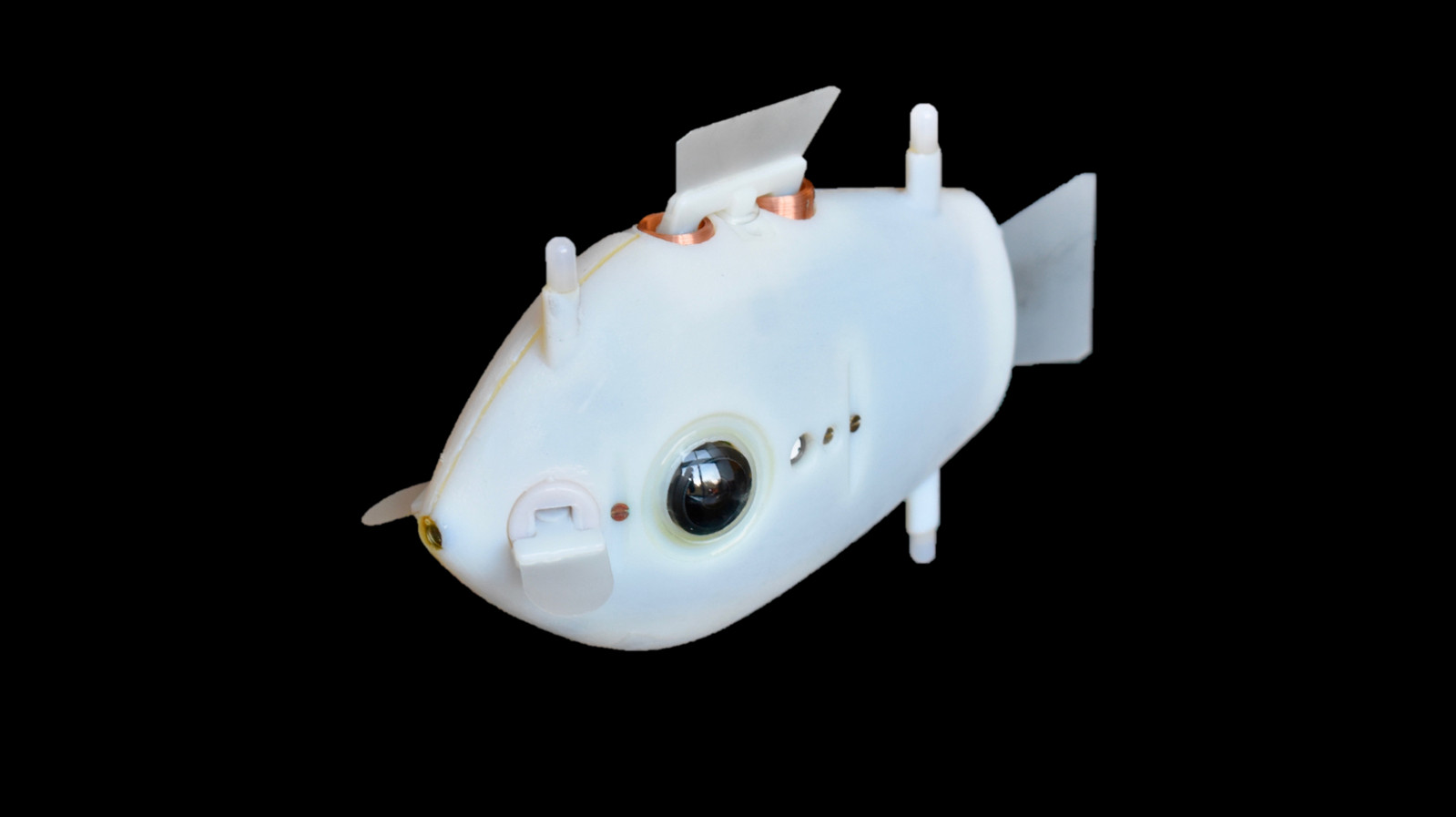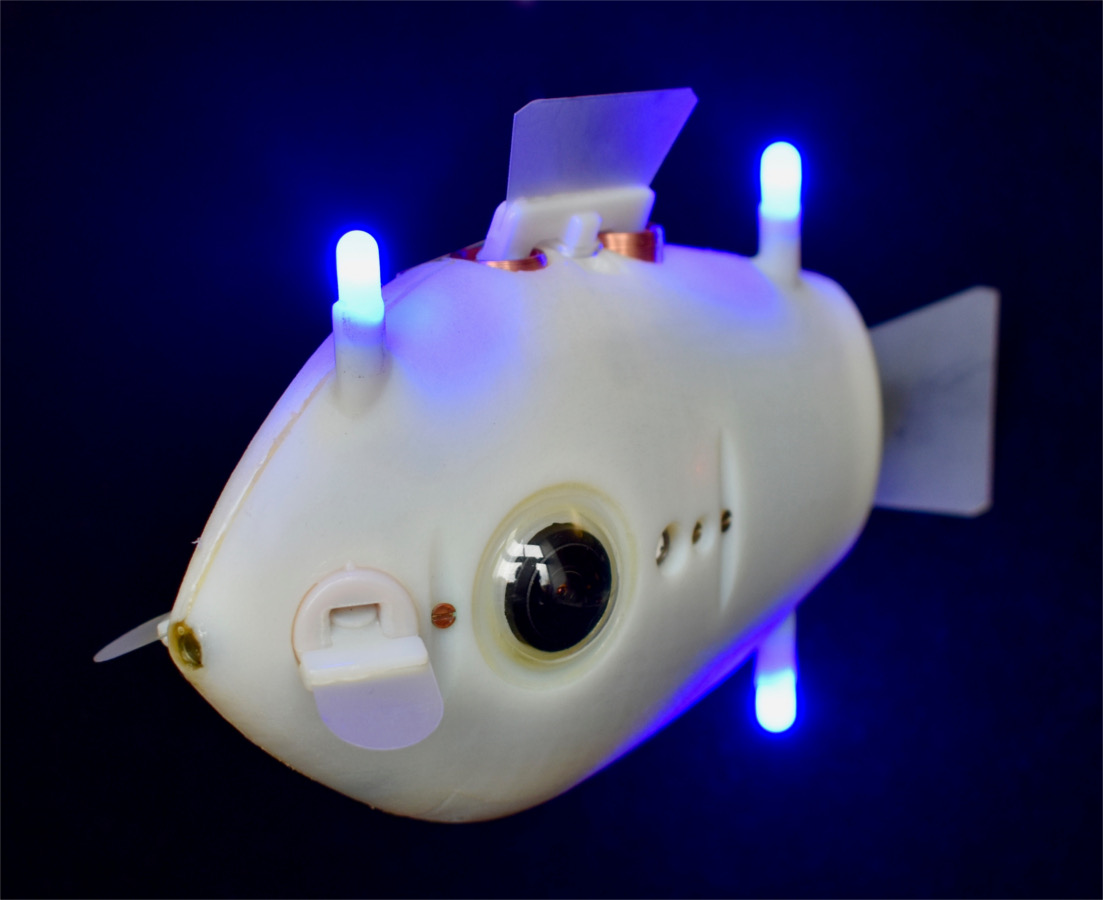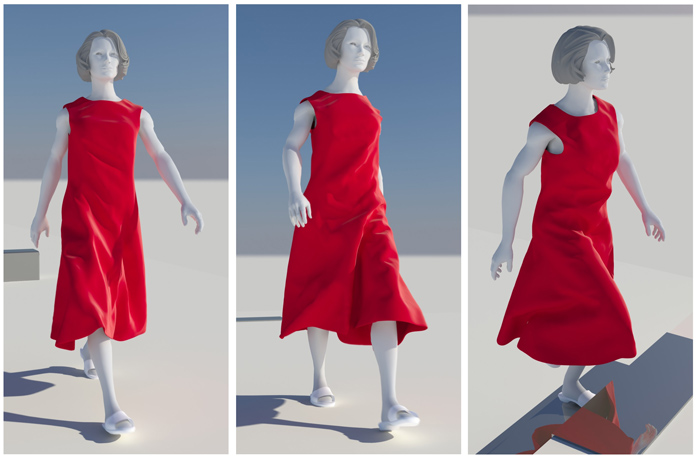Robotic Plasma Cutting in a 3D World
Women in Robotics Update: Andra Keay, Nguyen Sao Mai and Selin Alara Örnek
Here’s a Women in Robotics Spotlight, where we share stories from women who are working on all sorts of interesting projects who haven’t yet been featured in our Annual Showcase. We hope these stories provide inspiration to everyone to join us working in the field of robotics. And if you’re a woman working in robotics, why not contribute your story too!
“I love robots however I do find it frustrating when the code that was working the day before doesn’t work. I also find it hard supplying my robots with power. I learn online although I do have a few mentors that help me but it’s really not easy learning on my own. My favourite thing about robotics is making them, and when they work like they should. My robots make people really happy so I love that. I also love succeeding – the feeling when my robots come to life is unbelievable.” says Selin Alara Örnek a high school student who has built five robots, including a robot guide dog for the blind.
 |
Andra Keay Managing Director at Silicon Valley Robotics, Visiting Scholar at CITRIS People and Robots Lab and Founder at Women in Robotics
Why robots? “My background is Human-Robot Interaction, Design, and Communications Technology – which seems a long way from robotics, but our mass communication technologies (including internet) were the most powerful and creative technologies of the 20th century. I’ve always been interested in robots, firstly as a philosophical thing, then as interesting robots became possible, fascinated by the way in which this latest evolution of technology is spreading into society. The sheer scope of the technology is my favorite thing, but historically, the incredible homogeneity or lack of diversity in robotics is my least favorite thing. Fortunately, we’re changing that! We have technology that can solve the world’s greatest challenges, if we can continue to find ways to market and avoid frittering away our advances on novelty devices, games or advertising.” What suggestions do you have for other Women in Robotics? “Every time I was trusted to lead a project I grew a lot and gained confidence. Until then, I hadn’t even realized that I was lacking in confidence. At the time, it just seemed expected of young women to follow other people, not go my own way. I’d like to call out people on being too self deprecating, putting themselves down, or apologizing for themselves. If I had a dollar for every time a women in robotics has said “but I’m not really a.” then I’d be able to fund a great robotics company! I also call on people to stop blaming women for not speaking up or ‘leaning in’ when no one in industry is listening to them!” |
 |
Nguyen Sao Mai Assistant Professor at ENSTA-Paris, IP-Paris and also affiliated at IMT Atlantique
Why robots? Nguyen Sao Mai has enabled a robot to coach physical rehabilitation in the projects RoKInter and the experiment KERAAL she coordinated, funded by the European Union through FP-7 project ECHORD++. She has participated in project AMUSAAL, for analysing human activities of daily living through cameras, and CPER VITAAL for developing assistive technologies for the elderly and disabled. She has developed machine learning algorithms combining reinforcement learning and active imitation learning for interactive and multi-task learning. She is currently associate editor of the journal IEEE TCDS and co-chair of the Task force “Action and Perception” du IEEE Technical Committee on Cognitive and Developmental Systems. “Cognitive Developmental Robotics is a wonderful field to allow us to build new assistive robots that can evolve in interaction with humans and adapt to the needs of its users by continual learning. It is also an amazing tool to understand and model biological cognition and learning processes. Robotics is unleashing little by little its potential as a tool to address humankind’s challenges, such as the medical advances, environmental issues or social assistance for the elderly and the disabled. This year’s situation has for instance has shown the usefulness of robotics in medical environments and nursing homes.” What suggestions do you have for other Women in Robotics? “I would be happy to mentor or build a network to support younger women in robotics.” |
 |
Selin Alara Örnek High School Student and Inventor
Why robots? “I am a 14 year old high school student, I have been coding since I was 8 and building robots since I was 10 years old. I have built 5 robots till now one is a guide dog for blind people, ic4u and ic4u2, I have built 2 versions. I have another robot BB4All which is a school aid robot to help students, teachers and staff its main aim is to prevent bullying. I have also built an Android robot and a Starwars Droid DO as I love both of them. When I was 9 we lost our family dog I was really upset as I don’t have any brothers or sisters and he was like my brother. I wanted to bring him back to life as I was little I dreamed of bringing one of my soft toys to life. Whilst on holiday with my family I saw a guide dog with its blind owner. I love dogs and was really happy to see a dog helping in such way. But then I remembered how sad I was and I thought if the blind person’s dog was to die they would not only lose their best friend but their eyes again too. So I decided to build my robot guide dog ic4u. I am currently rebuilding BB4All as the first one I built was not very strong and made of cardboard now I am printing the pieces with a 3d printer and adding some more features. In my robots, I use image recognition, object detection, face recognition, voice commands, dialogflow, omnidirection movements, Google maps api and Google assistant integration and various sensors. I believe that robots will be part of our everyday life and that we will need them more and more. I love robots so that makes me really happy. My dream is to build a humanoid in the future and send it to space so that it can do research on the black hole.” What suggestions do you have for other Women in Robotics? “I used to love playing games minecraft, etc then in English class my teacher started making games for us to play whilst learning and I really wanted to do so. I asked him how he did it and he told me to have a look at MIT Scratch and encouraged me to code my own games. He told me I could do it and that I should try. That is how I started to learn how to code and I am very happy to have a teacher like him. A lot of girls are not very interested in coding robotics and find what I do very boring. I spend a lot of time taking my robots to events to talk about my robots and show how coding and robotics can be fun and also how technology can be used for good. I recently did a TEDx talk and have given presentations at plenty of local and international events. A lot of other kids get in touch with me to ask questions which I also like to answer. Especially little girls that get in touch as it makes me happy to see them so interested and excited. I also try to send messages to parents in my presentations and interviews, pointing out that they should respect their children’s choices and that they need to give equal opportunities to both their daughters and sons.” |
We encourage #womeninrobotics and women who’d like to work in robotics to join our professional network at http://womeninrobotics.org
Quest Industrial – Robotic Packaging Solutions
Brenton – Case Packing and Palletizing using both Robotics and other Automation.
Artificial intelligence must not be allowed to replace the imperfection of human empathy
Robotic swarm swims like a school of fish

By Leah Burrows / SEAS Communications
Schools of fish exhibit complex, synchronized behaviors that help them find food, migrate, and evade predators. No one fish or sub-group of fish coordinates these movements, nor do fish communicate with each other about what to do next. Rather, these collective behaviors emerge from so-called implicit coordination — individual fish making decisions based on what they see their neighbors doing.
This type of decentralized, autonomous self-organization and coordination has long fascinated scientists, especially in the field of robotics.
Now, a team of researchers at Harvard’s Wyss Institute and John A. Paulson School of Engineering and Applied Sciences (SEAS) have developed fish-inspired robots that can synchronize their movements like a real school of fish, without any external control. It is the first time researchers have demonstrated complex 3D collective behaviors with implicit coordination in underwater robots.
“Robots are often deployed in areas that are inaccessible or dangerous to humans, areas where human intervention might not even be possible,” said Florian Berlinger, a Ph.D. Candidate at the Wyss Institute and SEAS and first author of the paper. “In these situations, it really benefits you to have a highly autonomous robot swarm that is self-sufficient. By using implicit rules and 3D visual perception, we were able to create a system that has a high degree of autonomy and flexibility underwater where things like GPS and WiFi are not accessible.”
The research is published in Science Robotics.
The fish-inspired robotic swarm, dubbed Blueswarm, was created in the lab of Wyss Associate Faculty member Radhika Nagpal, Ph.D., who is also the Fred Kavli Professor of Computer Science at SEAS. Nagpal’s lab is a pioneer in self-organizing systems, from their 1,000 robot Kilobot swarm to their termite-inspired robotic construction crew.
However, most previous robotic swarms operated in two-dimensional space. Three-dimensional spaces, like air and water, pose significant challenges to sensing and locomotion.
To overcome these challenges, the researchers developed a vision-based coordination system in their fish robots based on blue LED lights. Each underwater robot, called a Bluebot, is equipped with two cameras and three LED lights. The on-board, fisheye-lens cameras detect the LEDs of neighboring Bluebots and use a custom algorithm to determine their distance, direction and heading. Based on the simple production and detection of LED light, the researchers demonstrated that the Blueswarm could exhibit complex self-organized behaviors, including aggregation, dispersion, and circle formation.

“Each Bluebot implicitly reacts to its neighbors’ positions,” said Berlinger. “So, if we want the robots to aggregate, then each Bluebot will calculate the position of each of its neighbors and move towards the center. If we want the robots to disperse, the Bluebots do the opposite. If we want them to swim as a school in a circle, they are programmed to follow lights directly in front of them in a clockwise direction.”
The researchers also simulated a simple search mission with a red light in the tank. Using the dispersion algorithm, the Bluebots spread out across the tank until one comes close enough to the light source to detect it. Once the robot detects the light, its LEDs begin to flash, which triggers the aggregation algorithm in the rest of the school. From there, all the Bluebots aggregate around the signaling robot.
Blueswarm, a Harvard Wyss- and SEAS-developed underwater robot collective, uses a 3D vision-based coordination system and 3D locomotion to coordinate the movements of its individual Bluebots autonomously, mimicking the behavior of schools of fish. Credit: Harvard SEAS
“Our results with Blueswarm represent a significant milestone in the investigation of underwater self-organized collective behaviors,” said Nagpal. “Insights from this research will help us develop future miniature underwater swarms that can perform environmental monitoring and search in visually-rich but fragile environments like coral reefs. This research also paves a way to better understand fish schools, by synthetically recreating their behavior.”
The research was co-authored by Melvin Gauci, Ph.D., a former Wyss Technology Development Fellow. It was supported in part by the Office of Naval Research, the Wyss Institute for Biologically Inspired Engineering, and an Amazon AWS Research Award.
How Unmanned Underwater Vehicles Could Become Easier to Detect – new research from Draper, MIT
What OEMs Look for in the Perfect Robot Supplier
Demo Day: the most exciting day of the year (Jan 28th, 3pm CET)

Multidisciplinary teams of minor students have designed and built a functional robotic prototype for a project customer with a challenge to improve the lives of working people. Streaming live from RoboHouse on the TU Delft Campus, you can join a virtual celebration of ideas en technology with some of our communities finest talent.
How does it work?
On Thursday 28 January 3pm (CET) you can visit the streaming website that we have created for the occasion. There you will find live video streams for a programme with a project overview and demonstrations by each student team. This all happens between 3pm and 4:30pm.
Our hosts will be running around RoboHouse for you, going from robot to robot and from team to team, followed by highly mobile camera people, all with the purpose of giving you the most intimate and direct experience. We want you feel as if you are able to touch the robots yourself.
After toasting on another successful Demo Day, the programme will go into free flow. You are invited to plunge into the various projects and splash around with anyone you like during the Breakouts. These start around 4:40pm and can be joined via Zoom-links that are available on the website.
All this wouldn’t be possible without our fantastic project customers: AI for Retail AIR Lab + Alliander + Deltares + Accell Group + Torso Doc + TechTics + Odd.Bot.
And of course, most appreciation and respect go to the eight talented student teams, who this edition go by the illustrious names of: Krill + ARMS + D.I.R.T + BikeBotics + Oxillia + BoxBot + Shino + Althea.
Welcome to the future of work!
About the TU Delft Minor Robotics
The Minor Robotics is a 5-month educational program for third year BSc students of Mechanical Engineering, Industrial Design, Computer Science, and Electrical Engineering from Delft University of Technology. A team of students from all above disciplines (to make sure they cover all knowledge needed in robotics) are working on building a robot for a customer.
Students follow multidisciplinary courses, and work in multidisciplinary teams to design, build, and program robots for customers. During the first months of the minor the students will focus on taking courses outside their own discipline (for example, the Industrial Design student will learn about programming and electronics, while a Computer Science student will learn about statics and prototyping). But they will also work on the design of their robot in close collaboration with the customer.
The last months are dedicated full time on building the robot and ends with a demo together with all other teams from the Minor Robotics.
Here’s a video of last year’s TU Delft Minor Robotics event at RoboHouse.
The post Demo Day: the most exciting day of the year appeared first on RoboValley.
How the Vision Transformer (ViT) works in 10 minutes: an image is worth 16×16 words
IMTS Spark “Demo Days” Features Interactive Demonstrations, Offers Six Concentrated Learning Opportunities
‘Bleep-bloop-bleep! Say “cheese,” human’
#327: Computational Design, with Bernhard Thomaszewski

Lilly interviews Bernhard Thomaszewski, Professor of Computer Science at the University of Montréal and research scientist at ETH Zurich. Thomaszewski discusses his background in animation at Disney, his current work on mechanical metamaterials and digital fabrication, and how physics-based modeling has connected the dots.
Bernhard Thomaszewski

Bernhard Thomaszewski is an Assistant Professor in the Department of Computer Science and Operations Research at the University of Montréal. Until June 2017, he was a Research Scientist at Disney Research Zurich, heading the group on Computational Design and Digital Fabrication. Thomaszewski obtained his Master’s degree and PhD (Dr. rer. nat) in Computer Science from the University of Tübingen. Before joining Disney, he spent a year at the computer graphics group at ETH Zürich.
Links
- Download mp3 (14.7 MB)
- Subscribe to Robohub using iTunes, RSS, or Spotify
- Support us on Patreon